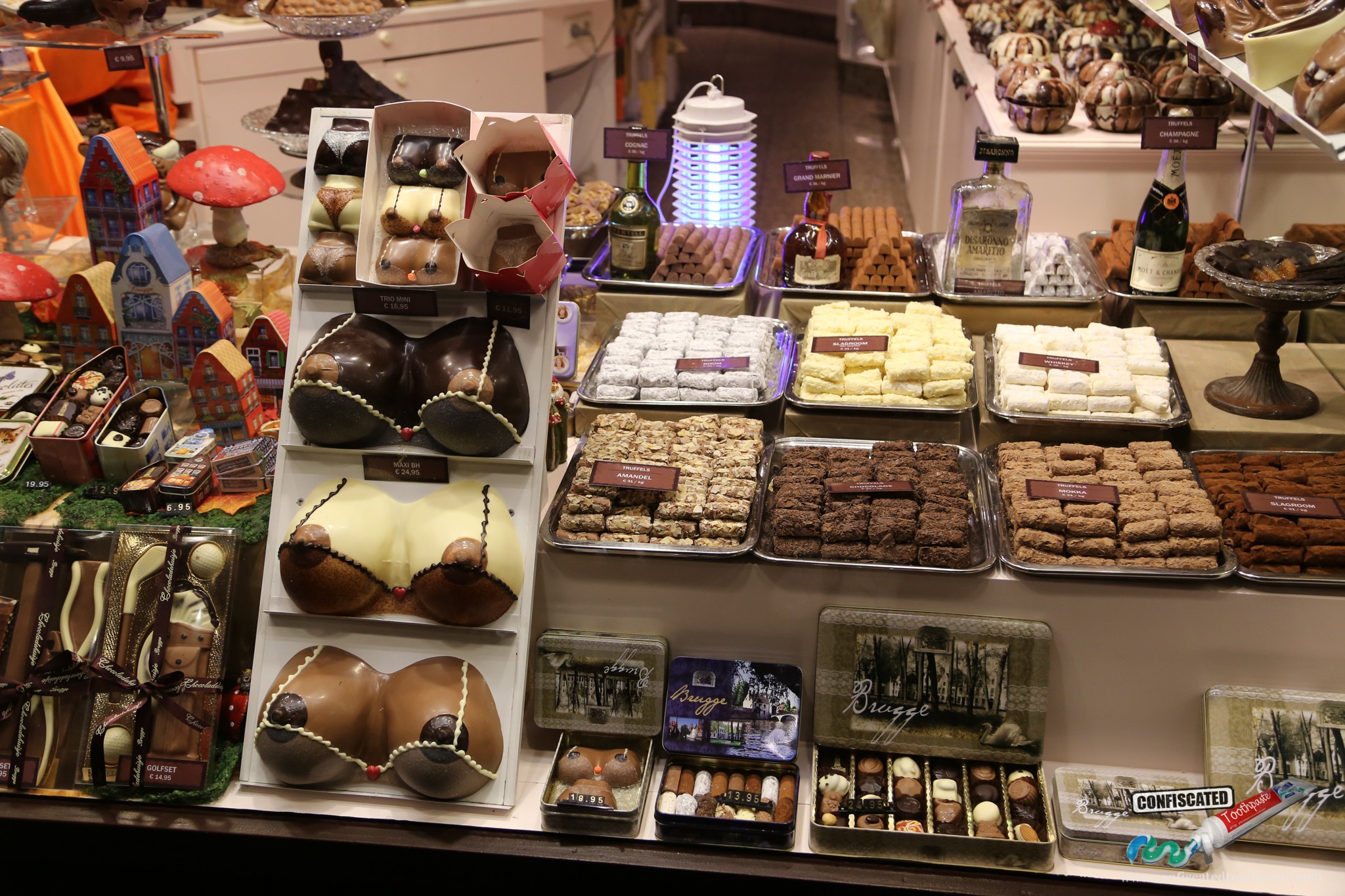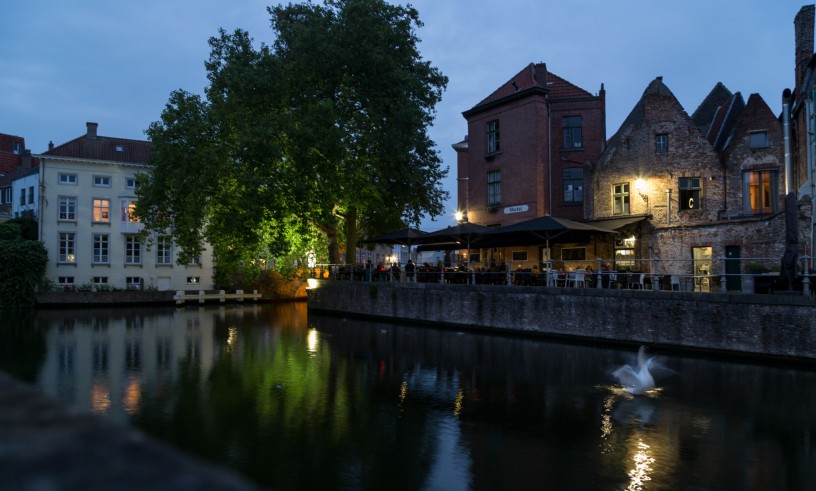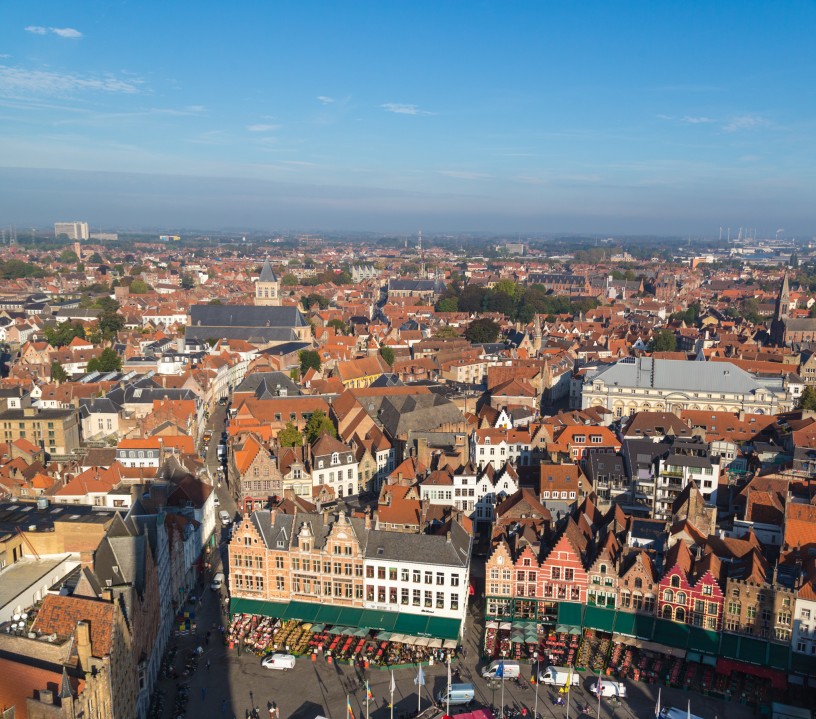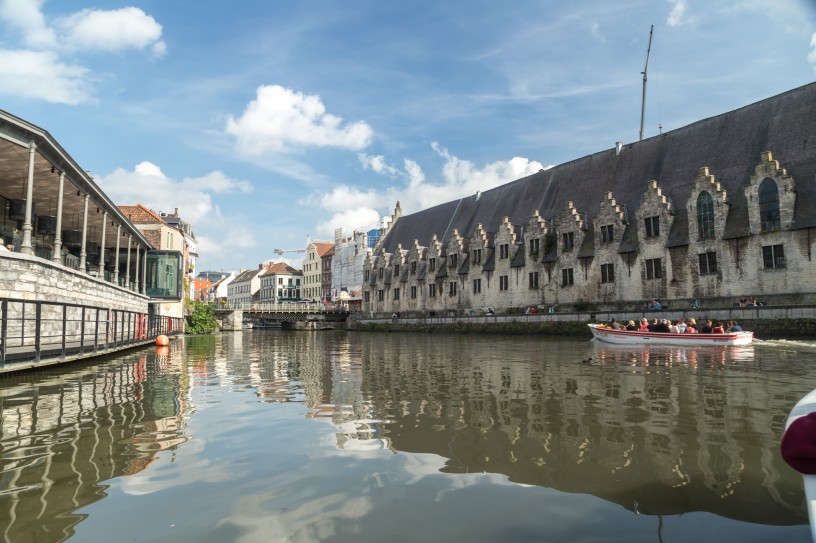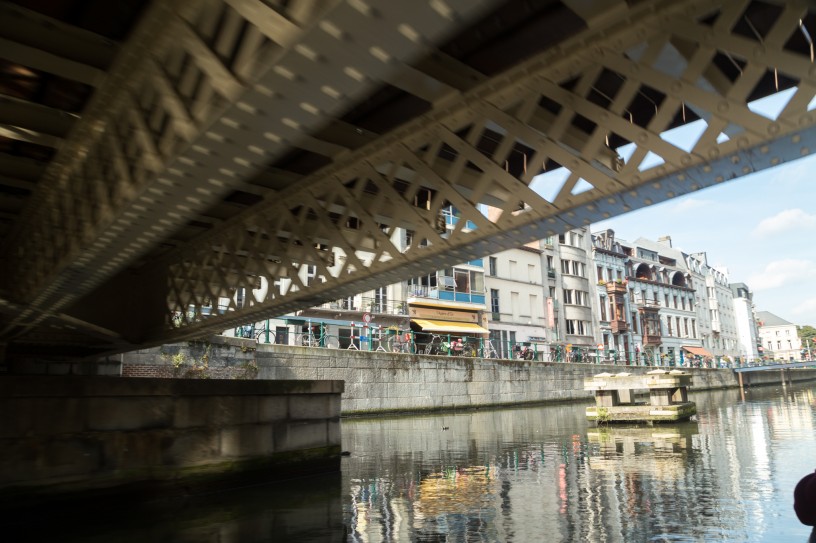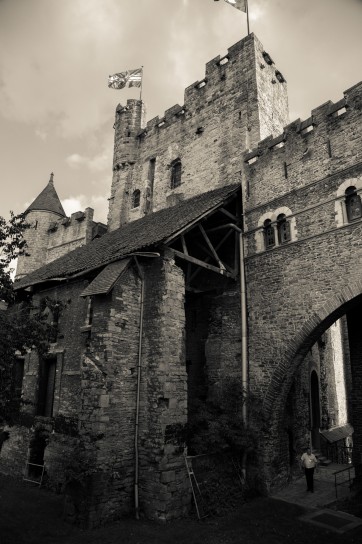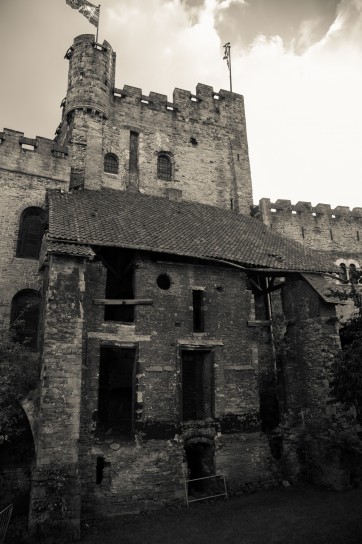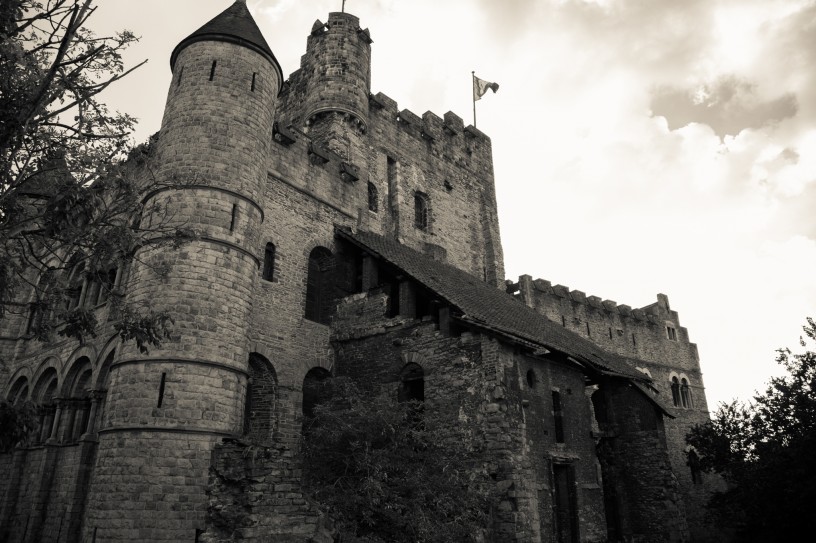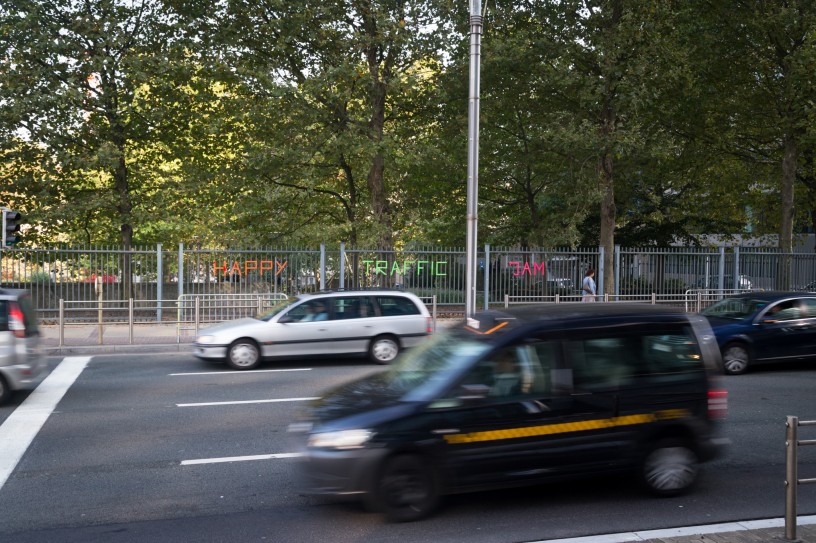A Roadtrip Through The Netherlands and Belgium
Part 2: Bruges, Ghent and Brussels
In last week’s episode, (Part 1: Amsterdam, Haarlem, The Hague and Zeeland), we’re unable to resist the tempation of a roadside corn maze and we’re running late for an important work conference call as we cross the border into Belgium. It begins raining torrentially, and somehow, inevitably, we miss a critical turnoff to Bruges and have to double back, wasting precious time. But I still don’t panic, because we’ve booked ahead of time, and the hotel website loudly proclaimed “FREE WiFi in all rooms and public areas”. What could possibly go wrong?
Bruges

We pull up outside the hotel with 10 minutes to spare before I am supposed to be online. Abandoning my agreed roadtrip duties, I leave the car with Ed to park. I do the check-in in record time and the lady gives me the Wi-Fi password. I dump the bags in the room, get online, and…
Nothing works. Nothing. Not only is the internet slow as a rock, but it doesn’t work at all most of the time. We begin the call, with an important party of Chinese investors, and it’s a disaster. Twenty minutes in and we are forced to abandon the conference, though the people that run the hotel try unproductively to help (“I’ll just reset the modem. Click!” No! Now I’m completely cut off! Arrggh!).
Ed arrives and I am thoroughly irritated and thoroughly in need of a beer and a nice place to drink it. My mood improves when I realise I’m in Belgium, world capital of both beer and nice places. We’re sitting at a bar on the Grote Markt drinking sweet blonde Leffe and suddenly life seems pretty good. The townscape is bloody-well astonishing, a fairytale conglomerate of step-gabled rooftops and gigantic churches. Across the square is the world famous Belfry, which is positively gargantuan.


“Why did they feel the need to build such a huge belltower in such a small town?” asks Ed.
“I don’t know,” I reply, “but I like this place. It’s ambitious.”
Ed is somewhat unimpressed. “If you like Bruges,” he informs me, “you’d love Ghent. It’s kind of like this but bigger.”
“Really,” I reply skeptically. I can hardly imagine a place as spectacular as Bruges.
But Ed is insistent. “Not only that, it’s a good party place too.”
“Ok then,” I say, my curiosity sufficiently stoked, “let’s go to Ghent next.”
But Ed has a problem. In 3 mornings from now, he is due to fly back to his home in Switzerland. The flight is from Brussels. We are both keen to spend 2 nights in Bruges so as to do this amazing place justice, but the question is where to go next. Ed accidentally booked a flight at 7 in the morning, so ideally he wants to go to Brussels next so that he can easily get to the airport that morning. On the other hand, I still have 5 nights left until I have to fly home from Brussels, but I definitely don’t want to spend all of those in Brussels.
Over the course of the evening, Ed realises his mistake in whetting my appetite for Ghent and tries to take it back. “It’s really much the same as this,” he says. “No point really going.”
“I’m sure there’s early trains to Brussels from Ghent,” I say.
“Ghent’s actually nothing special. It’ll probably be raining.”
We stand mesmerised as a procession of white swans glides silently down a beautiful canal next to ancient buildings, the full moon reflected in the water. There’s no cars around- it could be the 1800s, or the 1500s. It’s Europe at its most beguiling. Later that night, we eat waffles with melted chocolate and banana at a café overlooking the Dijver quay. The ancient and elegant patrician houses on the bank are softly illuminated; a huge willow tree hangs out over the water.
“Ed, why don’t you just try to change your flight?”
“Hmm. Not a bad idea Matty.”


There’s just one problem. Ed has booked his flight with some kind of bargain basement German company called Airline Direct. The first three times he calls, an automated message states simply that there are too many callers at the moment and to please call back another time. Somewhat taken aback by this strange approach to customer service, we place a call at 9 the next morning when the call centre opens. This time it is answered by a very confused German who replies simply “I don’t know” when asked if it is possible to change the flight.
“What do you mean, you don’t know?” Ed asks in German. “Who does know?”
“We will need to fill out an application and send it to the airline, and we should hear back in 3 to 5 days.”
“But my flight’s in 2 days.”
“Two days?” the operator asks incredulously, as if we’re making the most ridiculous request in the world. “No, that’s not possible.”
“Can’t you call the airline and ask them?”
“No,” says the German with the same air of incredulity. “That’s not possible.”
We try calling the airline but get the predictable response “As you have booked this flight through a travel agent, you need to contact the agent.” Meanwhile, while we waste time dealing with twits, Bruges is laying in wait outside, unexplored.



We start the day with a canal cruise, to acquaint ourselves with the town’s waterways. The guy piloting the boat is kinda funny in a “groan…” kind of way and it’s my first taste of dry Belgian humour. (Typical deadpan jokes include “here is the most important building in all Bruges- it’s the brewery”.) We soon realise that the Belgian driving culture is somewhat less appealing- despite Bruges being a cobbled pedestrian tourist zone, the few cars zoom around at startling speed, with countless near misses with pedestrians and bikes.
We also take a stroll through the Church of Our Lady, another imposing structure on the Bruges skyline complete with colossal tower and flying buttresses. It houses the famous sculpture Madonna and Child by Michelangelo, which was smuggled out of Bruges by both Napoleonic France and Nazi Germany. It was returned on both occasions, with the World War Two incident immortalised in the film “The Monuments Men”.
After lunch we decide to head up the impressive Belfry and get a bird’s eye view of Bruges, but there’s a problem- our investor meeting has been rescheduled for 3 pm today and the queue of people waiting to go up the tower is too long. Rather than risk missing my meeting again, we instead head to the Basilica of the Sacred Blood. Built between 1134 and 1157 next to the town hall of Bruges, it houses a venerated relic of the Jesus Christ’s blood, allegedly collected by Joseph of Arimathea and brought from the Holy Land by Thierry of Alsace, a Count of Flanders.
I’ve never been much for religion, but ever since our quest to get married in the world’s most beautiful church in Brazil, I’ve been interested in religious buildings and artifacts. We walk into the Basilica and take a seat before the altar, only to be told we’re facing the wrong altar. Whoops. A priest appears and holds a glass tube aloft. We file past the glass tube, one at a time. It has what looks like some ancient fluff inside it. Whether or not it is a cloth with holy blood on it, as claimed, I couldn’t say, but the pageantry is cool.



We return to the hotel, and I have the con-call using the hotel telephone rather than the internet this time. I am a bit worried about how much the hotel is going to try and charge us for that, but for now we decide to put that aside and drive to the beach, 15 km away.
As it happens, Bruges was once on the beach. The silting of the Belgian coast led to it being cut off from the ocean, before a storm surge in 1134 created a natural channel called the Zwin that swept inland and restored ocean access to Bruges. You’d never know it given its sleepy nature today, but Bruges then became one of the world’s premier commercial cities, at the crossroads of the famous Hanseatic League trade network for centuries. Finally in the 1500s, the Zwin again silted back up again and Bruges fell behind other cities in economic development.
Nowadays, Bruges is connected by canal to an important port called Zeebrugge (Bruges on the Sea). I’m keen to take in this amazing coastal history and smell the sea air, but we’ve got a slight problem.
We’ve lost the car.
You might remember from Part 1 that I had originally agreed to be the driver on this trip, because among other things, Ed told me he could not reverse park. When I had been late for the con-call yesterday, I left Ed to park the car, and he had to go a long way before he found a spot he didn’t have to reverse into. We then didn’t think about the car for 24 hours. Now he can’t remember where it is.
We walk the streets aimlessly for some time and I have visions of having to explain to Sixt that we’ve lost their car, somewhere on the outskirts of Bruges. After half an hour of searching, Ed is sure we’re in the right street, and then we can see our car, but then something horrible happens. A man driving the usual kamikaze manner comes down the street at speed and hits a kid riding a bike. The kid is not badly hurt, but is shocked and in tears and his older sister is also in tears and unsure how to handle the situation. Unbelieveably, the man gets out of his car and begins verbally abusing the two youngsters. It looks like a situation we’re going to have to intervene in, despite not knowing the local language, but mercifully some locals jump in and begin arguing with the man in Flemish and help the kids to the sidewalk. We don’t dilly dally in jumping in the car and exiting a bad situation.


At Zeebrugge, the tide is out, and when the tide goes out on such a broad, flat coastline, it goes out a long way. There are a jumble of restaurants and beach huts, and to the north the port breakwall lined with cranes. We walk about a kilometre out to sea before we reach the water. Looking back, the beach huts and restaurants are a long way away. One has to be careful walking on this coastline that you’re not trapped by rising waters when the tide turns.
That night Ed and I decide on a course of action regarding Ghent. We’ll head there tomorrow morning, as it’s on the way to Brussels anyway. We want to drop off the car there, because we’re heading inland now where the trains are the more convenient option, and unfortunately there’s no drop off point in Bruges. Once we’re in Ghent, we’ll try and contact a girl that Ed met there last time, and if Ghent’s nice and everything’s hunky dory, we’ll consider staying a night.
The next morning dawns bright and sunny and full of promise and we ready the car- but there’s one thing we haven’t yet done in Bruges and that’s the bell-tower. We race into town, there’s no queue, we go up a spiral staircase for what seems like forever, and at the top is the most incredible view of this wonderful UNESCO world heritage site. The bells go off while we are up there, 47 massive bells playing a song from an automated carillon. It’s deafening and unforgettable.

Ghent
We’re back in the car and heading to Ghent, and typically, we’re barely in the car half an hour before we’re taking the exit from the freeway. There’s tramrails and bike riders and pedestrians everywhere and tangled streets, but miraculously we find the drop off point without drama, and as usual with Sixt, the experience is nice and simple and there are no funny added charges.
We’re near the railway station and it transpires that we’re several miles from the centre of town. Since we’re now without vehicle, we drag our luggage to the station, deposit it, and begin the walk into town.
It’s a total bluebird day and the town is absolutely stunning. I mean it’s mindboggling- it’s hard to imagine a more incredible fairytale city. Not only that, but the vibe is busy- there’s a large university here and many students. In comparison to Bruges, there’s a strong sense that the city is alive and utilised, and not just by tourists. Oh- and there’s a castle. Ghent’s ticking all the boxes.




As we approach along the Ghent-Bruges Canal (so named because it runs between the two cities), the girl Ed met while he was here last time messages back, and she’s keen to meet up and party tonight. Even Ed is in agreement that staying in Ghent, rather than proceeding through to Brussels, is the best course of action.
So we duck into the tourist office and grab a map and try to work out where to stay. In the end, we end up at Hostel 47, a well appointed little budget place just outside the centre of town. We don’t regret it- the place is clean and sleek and quiet and there’s a garden where you can eat breakfast. Furthermore, the Belgian owner, Youri, is a very cool guy. When we tell him that our bags are all the way back at the train station, over an hour’s walk, he says “why don’t you go out and enjoy the city, and later this evening after peak hour finishes I’ll drive you over to get them.” We can hardly believe our good fortune.
Since by this time it’s already the afternoon and the day is ticking by, and Ed will be leaving for Brussels airport early the next morning, the afternoon itinerary is Ed’s choice. Ed’s keen for a beer and a canal boat tour to get acquainted with the city. Beer and boats have been a bit of a running theme the whole trip, and the sun’s out, so I can hardly disagree.


We join a boat next to the beerhouse on the Leie River. It cruises back down the Ghent-Bruges Canal, past the Graslei Harbour, the centrepiece of Ghent and the location of its oldest and most elegant step-gabled houses: the Grain Weighers house, the Guildhall of the Free Boatmen, and the Spijker. Young people relax on the banks in the sun with beers and friends.
We pass under ancient bridges and storehouses and turn left into the Ketelvest. We’re slightly outside of the medieval centre and in a more modern area of Ghent now. There’s colourful houses and commercial buildings, and we pass into the Reep behind the 13th century Fortress of Gerald the Devil. Access to this waterway is via a long, dark, watery underground tunnel.
On the way back we go past the Gravensteen Castle, and we pass under an adjacent bridge. Under the bridge, just above the waterline is a small 1-metre-by-1-metre hole in the brickwork with a grille across the front. It’s where prisoners on death row would spend their final night, freezing and cramped and lonely. No final meal requests here. It’s a reminder of the city’s distant but grim medieval past.

Next, Ed wants to go see the castle, so we pays our money and takes our tickets.
Gravensteen served as the seat of the Counts of Flanders until they abandoned it in the 14th century. The castle was then used as a courthouse, a prison and eventually decayed. Houses were built against the walls and at one time it even served as a factory. The castle was saved from demolition by the city and restored to its former glory.
We’re told that the castle will be closing in an hour, which sounds ok to us because there’s a lot of other stuff we want to do anyway. But what they don’t tell you is that really, they want you out of there in half an hour. We find this out up on the roof of the castle when a not-so-friendly man appears to shepherd us off the roof and back inside the castle.
By the time we reach the torture room, where various horrifying torture devices and a guillotine all used in Ghent are displayed, the unfriendly man is hot on our heels and allows us not more than about a minute to look around the room. I am extremely pissed off and tell him as much, but it doesn’t do much good, with other security guards appearing and a scene developing. Ten minutes prior to closing time, all the visitors are herded into the courtyard of the castle which leads out to the street. This is very clearly their goal so that they can close up and go home at 5 pm on the dot. The Gravensteen becomes the only negative point on our visit in Ghent, so if you want to go, make sure you visit earlier in the day.


We grab another beer and a spot on the river and the sun starts going down. After a burger at the buzzing Korenmarkt, we head back to the hostel where Youri makes good on his promise to drive us to the train station. He’s a traveller himself and we swap stories inside the hostel van on the way, and I can’t recommend he and his establishment highly enough. Definitely stay there if you are heading to Ghent!
Bags retrieved and all set for Ed’s early morning departure, we head out on the town. Ed is slightly miffed to discover that the girl he met last time in Ghent now has a boyfriend. But the dude is nice and friendly and has the same Belgian sense of humour we’ve grown to like.
We start the night at ‘t Dreupelkot, a tiny bar close to the beerhouse on the river we drank at earlier. ‘T Dreupelkot is run by a man named Pol, who distils his own Jenever, a potent Belgian liquor. I’m always a bit wary of home-distilled liquor but hey, this is Belgium, and the bar is full of happy imbibers- it’s clearly a bit of a Ghent institution, so who am I to disagree? There’s over 200 flavours of Jenever, everything from green apple to chocolate to pepper.
The locals are recommending the square at St-Jacobs Church for its nightlife, so we head over there and it’s a bit more bohemian and divey and that suits me fine. We have a couple of dark Leffes in Jos, a bar filled with black and white photographs of rock shows, before heading back to the hostel for some snooze action.



At some ungodly hour, poor Ed wakes up and traipses off to catch the train to Brussels airport. By the time I wake up I can hardly remember him going, but the room’s empty and it feels weird to be at my own devices. First the car’s gone, now Ed. It’s been a good trip together chatting about solar cells and girls and good times. But I rouse myself knowing there’s another day of exploring Ghent ahead of me.
In contrast to yesterday, today is dark and gloomy, but it’s not raining. I love this sort of weather in Europe, and everything in Ghent today feels more authentic and medieval and menacing. The light for photography is great, and I plot a course of exploration along the axis of three of Ghent’s most recognisable towers, St Nicholas’s Church, the Belfort and St Bavo’s Cathedral.




The Belfort amazingly is even bigger than the one in Bruges. The bells served to regulate daily life in the growing medieval city, with a bell called “Roeland” used to mark the hour as well as to warn of approaching enemies or a great victory. Gradually more and more bells were added, and a carillon built by the famous bellfounders Pieter and François Hemony in the 17th. The automated carillon now has 53 bells. Unsurprisingly, the view of Ghent from the belfry is pretty spectacular.



Meanwhile, the gothic St Bavo’s Cathedral, with its sprawling crypt, is notable for the Van Eyck masterpiece that resides within- The Lamb of God, also known as the Ghent Altarpiece. Like the Madonna of Bruges, it was pilfered by the Germans during the War, and features in The Monuments Men film. It really is an astonishing piece- I can’t seem to shake realism of the detail in Adam’s foot from my mind.
I also take in the area around St. Jacobs Church, where we passed last night, and the Leie River, and the Patershol quarter. The Patershol quarter is the medieval heart of the city and one of its most desirable neighborhoods, now filled with quirky restaurants. I’m exhausted so I grab a burger and afterwards sit down to enjoy a waffle with chocolate. It’s time to think about leaving for Brussels, so with light fading I grab my bag from the hostel and drag it to the nearby Dampoort station.



Brussels
Dragging my bag for 15 minutes might be the first reminder of what life with no car is like; the second is the train from Dampoort to the main Ghent Station (St Pieters). The first train I’m supposed to catch is for some reason cancelled; the second moves at the speed of an unrushed sloth. It’s meant to be a short trip skirting town but by the time we arrive at St Pieters, I’ve missed my connection to Brussels and the next train’s not for an hour. It’s pretty late at night by the time I roll into Brussels Centraal.

No matter, I console myself, knowing that I’ve got a bed at my colleague Monica’s place, and that Brussels is really the end of the line for this trip- I’ll have two nights here and then fly out to Singapore and home to Sydney.
After a couple of changes on the Metro system, and a late night walk through foreign neighbourhoods, I arrive at the apartment in Etterbeek where Monica lives with her husband Antoine and two young children. To my delight there’s a bit of a dinner party in full swing, complete with pasta and wine and Belgian chocolate. Antoine and the guests are French, so there’s a fair bit of French going on all of a sudden and I follow along best I can.
Actually, Belgium is a pretty interesting place as far as language and culture goes. In Flanders, where our roadtrip was focussed, they speak Flemish, which as far as I can make out is basically Dutch. In Wallonia in the south, they speak French. There’s a fair bit of political tension (ie, they mad hate each other) between the two regions, with secession movements quite popular in Flanders. I’m about to find out that Brussels is considered a third separate region of the country- here they speak both French and Dutch.
Like Amsterdam, I’ve been here once before when I was 17, half a lifetime ago. In fact, I was in Brussels when I received my high school results, prior to beginning my engineering studies at university, so when I awake the next morning I’m keen to rediscover this place.
I start by wandering through the Parc du Cinquantenaire (Jubelpark), with its impressive centrepiece triumphal arch, which commemorates Belgian independence. There’s a major traffic tunnel running under the park, but quite bizarrely the traffic emerges from the tunnel in the centre of the park only to enter into another tunnel 100 metres further on and disappear. Whether or not this is to give the traffic a view of the arch or for some other reason I am not sure, but it sure makes for a strange sight in the middle of the park.



On the other side of the park is the European government area, which I’m keen to see because I love politics. There’s the EU Council building, the EU Commission Headquarters and the EU Parliament building, Europa. I then catch the Metro into the centre of town.
The Grand Place (Grote Markt) is yet another UNESCO World Heritage Site. I’ve seen a lot of splendid squares on this trip, but the Brussels Grand Place, with its town hall and guildhouses in Gothic, Baroque and Louis XIV styles, is undeniably beautiful.
I also visit the Cathedral of St. Michael and St. Gudula, where I come face to face with a woman that looks exactly like a girl I dated more than a decade ago. She doesn’t acknowledge me, and I’m so perplexed by the encounter that I later message said girl to ask if it were her. She replies bemused saying that she’s elsewhere in Europe. False alarm then.






On a winter’s night in 1997, I walked with my father through a dark and snowy park in Brussels. I come across it and identify it as Parc de Bruxelles. On the perimeter of the park is the Royal Palace, which overlooks the Mont des Artes Gardens, with a glorious view over the city.

My friend Kristina, a lawyer who works with European Commission regulations, is staying in Ixelles and I head over there to meet her for dinner and drinks. Ixelles is full of little Art Nouveau bars and restaurants and reminds me a bit of Paris’s St Germain- it’s bohemian and chic. We have a couple of beers and then head to a little restaurant, where we are denied a table due to their being “too busy”. The place is half empty.
“Do you think they just don’t like the look of us?” I ask vexed, given we are a not a particularly poorly-groomed pair. Kristina, who speaks French, assures me this is just part of Belgium’s inconvenient eating culture. It’s not the first time I’ve been unimpressed by the service at Belgian restaurants- throughout Belgium I’ve been told certain items weren’t available, been kicked out due to the owners wanting to close, or kept waiting ungodly lengths of time for food to arrive. We’re rejected from another place who say they are “at this hour only taking reservations” before finally we get a table at a pasta place. The food takes half an hour to arrive, and I’m halfway through my dish before realising it’s not what I ordered. Not wanting to screw around any longer, I eat it anyway.
I’m looking forward to a late night rendezvous with Monica and Antoine but when I arrive home, they’re sleeping and the place is dark. I tip-toe inside so as not to wake the youngsters.
The next morning, my last in Europe on this trip, the 3 of us and the 2 kids ride bikes out to Parc de Woluwe. It’s yet another beautiful day and we sit by a pond with ducks and swans all around, while I reminisce on the trip. We wander through a marketplace where Antoine picks up an old film camera.
Antoine is keen to head to a bar-restaurant he’s heard of for lunch. I order a pizza, and true to form 45 minutes later we are still waiting. It seems there is only one waitress for about 40 customers. My last day is ticking past, and I am grateful when Monica and Antoine offer to take my bike home so that I can head out to the city one more time.

I head to the Palais de Justice, an imposing edifice and the most important court in Belgium, and then to see the Mannekin Pis, the most famous statue in Belgium. Like the name implies, the mannequin is of a small boy taking a piss. I am kind of amused to see so many tourists crowded around to take a look at something so unremarkable. The boyfriend of the girl we went out with in Ghent told me that Brussels actually has a new statue now, of a young girl taking a piss, “but she isn’t as popular”. Mannekin Pis has been comically dressed by somebody in a Scarlet Pimpernel outfit, and I am left with this legacy of the odd Belgian sense of humour as I head to the airport.
That’s all for now folks. I hoped you enjoyed the tale of my roadtrip through the Netherlands and Belgium. Look out for a video of the trip coming soon.

